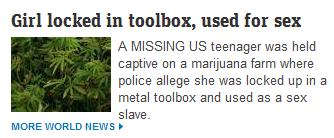Journalists have a very important and privileged position in our society. They control what news stories we get to know about, and the way we tend to think about those stories. The words they use to describe a crime become the words we use to describe that crime. Which is why it matters when they get their reporting so wrong, like they do almost every time they report male violence against women. They focus on the victim and what she was doing, and barely mention the male perpetrator of that crime. As a result, when we talk about sexual assault we talk about women when we should be talking about men.
Take this story by Megan Levy on smh.com.au: Unconscious mother raped in toilet block while daughter cowered in cubicle:
A mother was knocked unconscious and raped in a public toilet block while her six-year-old daughter cowered in a cubicle just metres away on the NSW south coast, police say.
Australian journalists use the pyramid style of reporting, which puts all the important bits in the first sentence. There’s no mention of the man who did it, so Levy clearly didn’t think the man who committed the crime was an important part of her story about his crime.
The second sentence offers up an excuse for his actions – he’d been drinking:
The 37-year-old woman woke to find the man, who smelled like cigarettes and alcohol, lying on top of her on the floor of the toilet block in Batemans Bay late last month. He then ran away.
What is more important – that a man hit a woman so hard he knocked her out and then he raped her, or that the victim was 37, the daughter was six, the daughter was in a toilet cubicle, the cubicle was a few metres away, the toilet block was in Batemans Bay, Batemans Bay is on the south coast of NSW, it happened a few months ago, and the attacker smelled like cigarettes and alcohol? It’s a tough one, I know. It’s the kind of thing that would keep you up at night, wondering if you’d made the right decision about what was more important in your story about a violent crime.
The third sentence about what he did doesn’t even mention him at all:
Detectives initially believed the woman had been indecently assaulted during the attack, however they now say she was raped in the minutes that she lay unconscious on the toilet block floor.
Here Levy, let me fix that for you: “Detectives initially believed the man indecently assaulted the woman during the attack, however they now say he raped her”.
Later, Levy writes “The mother was then punched and knocked unconscious, before she was sexually assaulted”, when she should be writing “The man punched the woman, knocking her unconscious, and then he sexually assaulted her”. This is not complex stuff. The words we all use to talk about male violence are important. As Jane Gilmore writes in her excellent piece about male violent crime, the phrase “violence against women” means “Violence is the subject, women are the object, and the perpetrators of the violence aren’t part of the discussion”.
I know I keep going on about this, but journos don’t report other crimes this way. I used to give them the benefit of the doubt with this stuff. But this is not news to them. I know journos read these posts. Some of them contact me to say thank you, and some of them ask for advice on their stories. I’ve emailed Levy before about this. But there’s also the sub editor at smh.com.au and the homepage editor who didn’t see a problem with the way this story was reported. They either didn’t notice, or didn’t care, that the story about a man’s crime barely mentions him at all.
Update 15 December 2014:
Another horrific story about a man killing a woman but you wouldn’t know he did it by reading the headline: Deer Park woman found dead in suspected murder-suicide
On theage.com.au homepage, journos have minimised the man’s role in his violence:
But that’s not the worst bit. I am absolutely gobsmacked by this comment from the cop in charge of the investigation:
Homicide Detective Sergeant Paul Tremain said police were aware of a history of domestic violence going back to at least 2012.
“There was an intervention order taken out in 2012 which expired four days ago,” Detective Sergeant Tremain said.
“These are just shocking circumstances of two people who couldn’t work out their differences and it’s ended in a tragedy like this,” he said.
COULDN’T WORK OUT THEIR DIFFERENCES? WHAT THE ACTUAL FUCK? They “couldn’t work out their differences” is what you say when a relationship ends. It most definitely is NOT what you say when a man with a history of being violent, threatening or abusive towards a woman decides to murder her. Tremain’s attitude is appalling. Australia has a huge problem with male violence against women, and many people have attitudes that excuse that violence. Journalists who interview neighbours for quotes about what a “nice guy” the murderer was are part of the problem because they are trying to excuse his actions. And yes, Detective Sergeant Paul Tremain, you are also part of the problem.







